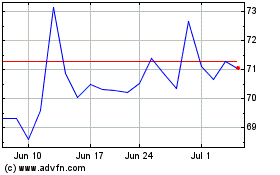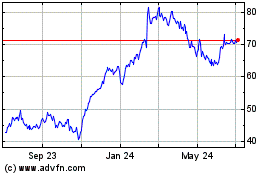Uber Is Still Riding Low
August 06 2020 - 6:51PM
Dow Jones News
By Laura Forman
Uber's ride-hailing business isn't exactly riding high amid
economic re-openings. Investors who have bid up the stock this
month in anticipation of a recovery are now questioning just how
easily the company can navigate future dips.
Uber's mixed results on Thursday were a sign the ride-hailing
industry may be less resilient than investors hoped. Second-quarter
gross bookings came in below estimates, falling 35% year-over-year
to $10.2 billion. Importantly, gross bookings for its rides
business -- now renamed "Mobility" -- declined 73%.
Uber said in May that it had been seeing early signs of
recovery, albeit one that was uneven across geographies. That has
continued, with bookings in countries like France improving
significantly, while bookings in various regions of the U.S. remain
down 50% to 85% from a year earlier. On the positive side, Uber's
food delivery business continues to grow, with bookings more than
doubling from a year earlier.
Uber aims to achieve overall profitability by the end of next
year and has put aggressive cost-cutting measures in place. To its
credit, Uber's rides business remained slightly profitable on an
adjusted basis, even as ridership fell. And its July move to
acquire food delivery rival Postmates promises to bolster cost
savings through synergies and more rational pricing
longer-term.
But sustainable profitability will require both ride-hailing and
food delivery to be firing on all cylinders -- something that looks
less likely as the coronavirus pandemic stretches on. Excluding
one-time costs, Uber's second-quarter adjusted loss before
interest, taxes, depreciation and amortization widened 26% in the
June quarter versus the year-ago period. In a conference call with
investors, the company said it expected Eats adjusted operating
losses in the third quarter to be roughly in-line with the second
quarter, but improve in the final quarter of the year.
From a valuation perspective, Uber is back to pre-pandemic highs
at around 3.7 times enterprise value to forward sales. Meanwhile,
it continues to straddle both sides of the shelter-in-place trade:
the Eats business is a natural hedge to declines in rides, but
upside appears limited in any scenario.
In such a tumultuous market, Chief Executive Officer Dara
Khosrowshahi stressed that "hope is not a strategy." Investors
should take this to heart. It isn't yet clear that Uber has chosen
the right road map.
Write to Laura Forman at laura.forman@wsj.com
(END) Dow Jones Newswires
August 06, 2020 18:36 ET (22:36 GMT)
Copyright (c) 2020 Dow Jones & Company, Inc.
Uber Technologies (NYSE:UBER)
Historical Stock Chart
From Mar 2024 to Apr 2024

Uber Technologies (NYSE:UBER)
Historical Stock Chart
From Apr 2023 to Apr 2024
